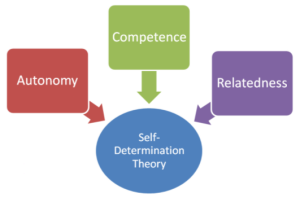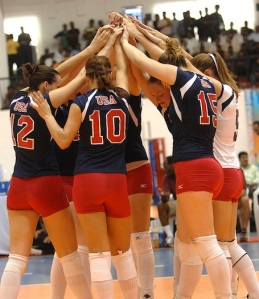This past month at the 2014 AASP (Association for Applied Sport Psychology) Conference I had the privilege of hearing Edward Deci Speak. Edward Deci is a world renowned researcher who is most famous for his work with Self Determination Theory. Self Determination  Theory states that athletes have three basic needs that need to be filled in order to foster intrinsic motivation; competence, autonomy, and relatedness. Intrinsic motivation is something we experience in instances where we are motivated to do something because we enjoy it, the task engrosses us, and we don’t require external rewards to keep our motivation. When athletes are driven by this type of motivation they tend to excel; when we love something we want to do it all the time and have the desire to improve. An atmosphere that fulfills the above needs for athletes is called a needs supportive environment. These are environments where athletes can truly thrive and reach their maximum potential.
Theory states that athletes have three basic needs that need to be filled in order to foster intrinsic motivation; competence, autonomy, and relatedness. Intrinsic motivation is something we experience in instances where we are motivated to do something because we enjoy it, the task engrosses us, and we don’t require external rewards to keep our motivation. When athletes are driven by this type of motivation they tend to excel; when we love something we want to do it all the time and have the desire to improve. An atmosphere that fulfills the above needs for athletes is called a needs supportive environment. These are environments where athletes can truly thrive and reach their maximum potential.
Competency: Athletes need to be able to demonstrate their abilities in order to feel as if they are competent in their sport. Autonomy: Encouraging autonomy through self initiation and choice reinforces their internal drive by giving them more control over their progress and success. Relatedness: Showing athletes that they belong and are apart of something bigger than themselves fosters our universal need to belong and interact.
So as a coach how do you create a needs supportive environment that caters to your athletes needs  and fosters intrinsic motivation? Below are a few simple ways coaches can do just that. As you read through the following examples keep in mind pressure is the number one killer of intrinsic motivation.
and fosters intrinsic motivation? Below are a few simple ways coaches can do just that. As you read through the following examples keep in mind pressure is the number one killer of intrinsic motivation.
Relatedness:
Try to relate and understand your athlete’s perspective. Acknowledge their emotions and the way they see things. Listen to your players and validate the way they feel. “I know it’s hot out and you guys are working hard, I appreciate that.” “I know it’s boring to take 70 swings at a hitting station by yourself.” Let them know that you can relate!
Provide meaningful feedback. Be specific; a simple “good job” doesn’t inform the athlete which skill they performed well. Make sure you insert a specific aspect in your praise. For example; “That was great, you kept your hands inside the ball on that  last swing.” Try to give feedback immediately after the action is committed. Giving feedback so quickly helps to reinforce specific skills as opposed to whole performances. By giving athletes meaningful feedback you are conveying that you care about their progress, your athletes will feel like their progress is an important factor in the teams success.
last swing.” Try to give feedback immediately after the action is committed. Giving feedback so quickly helps to reinforce specific skills as opposed to whole performances. By giving athletes meaningful feedback you are conveying that you care about their progress, your athletes will feel like their progress is an important factor in the teams success.
Give a rationale for requested behavior. If coaches offer reasons for the behaviors they request from their players, the athletes feel less controlled. On the team I currently coach, our players were braiding each others hair during our warm up time. As the coaches we told them this behavior was unacceptable. At first they were frustrated and angry; they wanted everyone to look uniform and ready for competition. After we explained that hair braiding needs to take place prior to warm ups because it’s distracting, they were more accepting of our rule change. They now understand that it is hard to mentally prepare to play a softball game when they’re physically focusing on braiding hair. Giving reasons for the rules and expectations of the team helps athletes to feel on the same level as the coaches, they are apart of the team, not being controlled by the team.
Autonomy
Encourage self-initiation and experimentation. Intrinsic motivation is derived from doing something because you enjoy it, and want to succeed or participate. Encouraging self-initiation and experimentation gives athletes control over their progress and success. Allow them to try new things, and find new ways to succeed. Let them be apart of the coaching process. Ask them what they think they should do to better their performance and then help them create an action plan to attain it. Make it their choice to get better.
Offer relevant choices. Reinforce the autonomy of your athletes by allowing them to make relevant choices. For instance, if you know you are going to work on both defense and offense at practice, why not let them choose which one they do first? Allow them to put together their own warm up routine, like I’ve mentioned before in my blog; Autonomy breeds pride.  Pressure kills intrinsic motivation; try not to force your athletes to work hard or even participate. Give them the choice, they know what the consequences are but the choice to participate is completely up to them. The key to this approach is keeping emotion out of your voice. Implying you will be angry depending on the choice they make is the same thing as demanding they participate or work hard. Use an even tone and let them know the choice is up to them. When they do choose to participate, you are reinforcing their autonomy by encouraging self initiation.
Pressure kills intrinsic motivation; try not to force your athletes to work hard or even participate. Give them the choice, they know what the consequences are but the choice to participate is completely up to them. The key to this approach is keeping emotion out of your voice. Implying you will be angry depending on the choice they make is the same thing as demanding they participate or work hard. Use an even tone and let them know the choice is up to them. When they do choose to participate, you are reinforcing their autonomy by encouraging self initiation.
Competency
Calibrate for optimal challenge. Athletes need to practice and compete at the edges of their abilities. This way they fail and succeed at a rate that keeps them motivated. Make sure practices, and the level of competition pushes your players but also allows them to achieve success. This threshold of success and failure reinforces their need to feel competent. They will be able to demonstrate their competency by improving and achieving success despite their failures.
Focus on indirect rather than direct competition. Indirect competition refers to athletes competing against themselves, whereas direct competition is when athletes compete against an opponent. When athletes compete against themselves, they focus on progress and being their personal best. There is less pressure in the situation and they can easily see their progress, in turn driving their motivation to keep progressing. I’m not suggesting that all direct competition is bad. It’s important that when athletes partake in direct competition, their personal best is acknowledged and you as a coach reinforce the parts of their performance they can control. Athletes can never control the performance of their opponent, they need to focus on their own personal performance to succeed and recognize their progress. I talk a little bit more about this in my blog: Where is Your Confidence Coming From?
Minimize use of controlling language. When athletes continually hear must, should, or other language that controls their actions, they feel as if they aren’t good enough to govern themselves. It also evokes pressure which again is an intrinsic motivation killer. Try to keep the controlling language to a minimum and let your athletes thrive.
They key to producing elite athletes is instilling a love for the game, something they will come back to over and over again simply because they love the sport.
Quote of the day:
“Somewhere behind the athlete you’ve become and the hours of practice and the coaches who have pushed you is a little girl who fell in love with the game and never looked back… play for her.” – Mia Hamm

Thank you Sarah for the article. Motivation and the Mental aspect of the game are going to be my primary focus this off-season and in my regular season. I have talented athletes who perform great at practice and somehow forgot who they are on game day. I would love nothing more than to correct this. I just need the tools and the time.